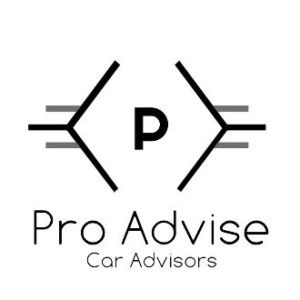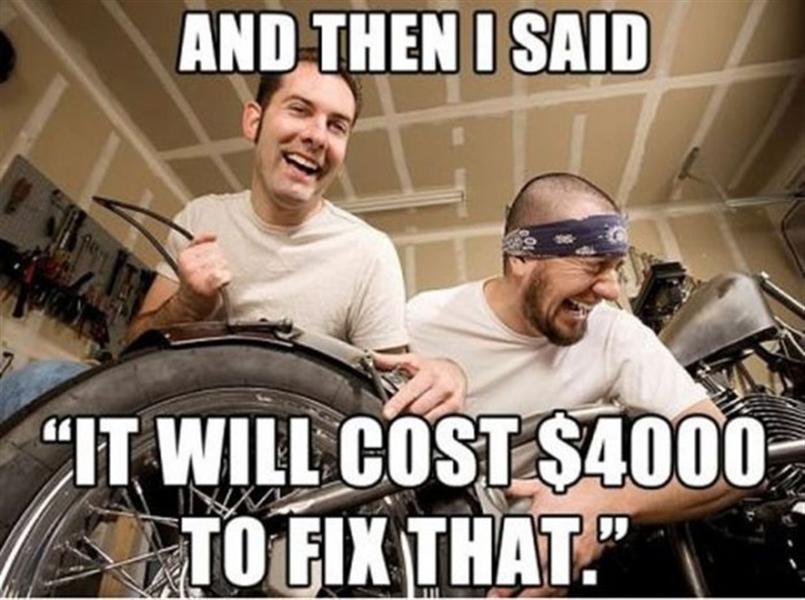
ProAdvise Car Advisors – Tech Review
Thabiso Malimela. 04/08/2017
As much as some of us would like to deny it, but before we start giving it cute names, a car is fundamentally a machine that is designed to be just that in the first place. And because it is a machine, it has various mechanical sub-systems that work together to sing the automotive tune in perfect harmony. Think of a car as you would a metropolis: in a capital city you have various departments working together to maintain the economy of the country and its people. So you would have hospitals, banks, schools, courts, residential apartments and even amusement parks and tourist attractions. Each of these places serve their own specific function but without one of them, the whole city would be brought to its knees. So like a metropolis, a car, being the big and expensive machine that it is, is run by various mechanic or electric systems which can all be categorised into five fundamental sections: Powertrain, Drivetrain, Chassis, Suspension and Wheels and Tyres. Although each section can be thoroughly explained in a one thousand page textbook of its own, for you I will focus on the basics that every car owner or aspiring car owner must know – sorry anoraks, you can go back to your textbook now.
In this article we will be discussing the first two most expansive topics of those five: The Powertrain and The Drivetrain. The last three sections will be covered in another article (we don’t want to make the article too damn long). Coming up next is a list of both sections and a comprehensive explanation as to what they are and what function they serve to the car:
The Powertrain
Notice the root word – ‘Power’. This already explains the basic function of the powertrain – to provide mechanical (and sometimes electric) power to move the car forward. The entire bulk of this section, if not all, is concerned with the engine of a car. What is an engine you may ask? (Pulls out engineering textbook) By engineering and physics terms, an engine is any device that converts energy into useful motion. So essentially that thing that goes vroom vroom (and sometimes vrr phaa) is just converting one form of energy (Potential Energy) into motion (Kinetic Energy). Some of you may have caught on already, but in case you haven’t, the initial energy source is the fuel (petrol, diesel or even electricity).
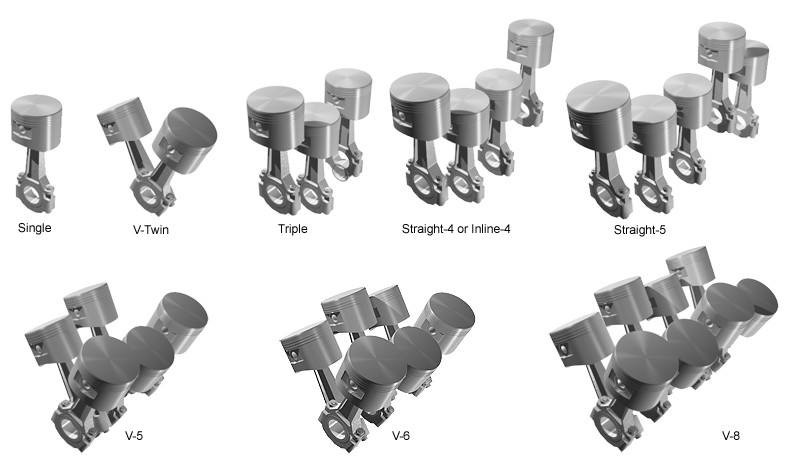
- The different configurations of an engine. Each configuration has its own advantages and disadvantages that are directly related to its characteristics
The fuel goes from your petrol tank and into your engine where it undergoes a combustion process (basically a small explosion) that forces a rotary or circular motion which is what ends up at the wheels. Remember, “The wheels of the bus go round and round”, not up and down! (If up and down, please consult your nearest mechanic). The engine you’ll find in 90% of the cars out there is called the internal combustion engine. This means that the aforementioned combustion process happens in an internal chamber called the cylinder. An engine will have various number of cylinders, and each of these cylinders will have a specific volumetric size, commonly measured in litres. So for example, let’s take a car that a lot of people love: the W204 Mercedes C63 AMG with a 6.2 litre naturally aspirated V8 petrol engine (codenamed M156). This engine has 8 cylinders, each with a volume of about 0.776 litres and when you multiply this by the number of cylinders it has, 8, you get the total volume of 6.208 litres and this is called the displacement of the engine. Generally, a car with a bigger displacement (bigger total cylinder volume) will produce more power but use more fuel than one with a smaller displacement. A car with a greater number of cylinders will produce more power but also use more fuel than a car with less cylinders.
Saying that an engine is naturally aspirated just means it has no turbocharger or supercharger. The turbocharger and supercharger force air into the engine, thus compressing it and increasing the power of each explosion occurring in the cylinders, the only difference being how they work – but more on that in another article (wink). Fundamentally, an engine goes through four processes: Intake, Compression, Ignition, Exhaustion.
- Intake – where the car takes in the air. The air goes to the air filter (engines like clean air), then to the intake manifold (or carburettor where it is mixed with fuel if you still live in the 1980’s) and then on into the cylinders where fuel injectors inject a fog of fuel to create an air-fuel mixture.
- Compression – where the air-fuel mixture is compressed or squeezed. This is good because the air-fuel mixture produces more powerful explosions when compressed (hence why turbochargers and superchargers increase power).
- Ignition or Power – where the spark plug literally ignites the compressed air-fuel mixture and BAAM, an explosion! During this stroke, the force of the explosion pushes a piston downward which rotates a shaft that connects to the gearbox and the powered wheels.
- Exhaustion – the leftover gasses of the explosion get pushed into the exhaust pipe. The pressure of these gasses create the lovely (and sometimes horrible) sound that all cars make. The pops you get on some cars like the GTI can be attributed to the leftover and unexploded fuel particles that escape into the exhaust pipe and get exploded there, since the exhaust is hot too.
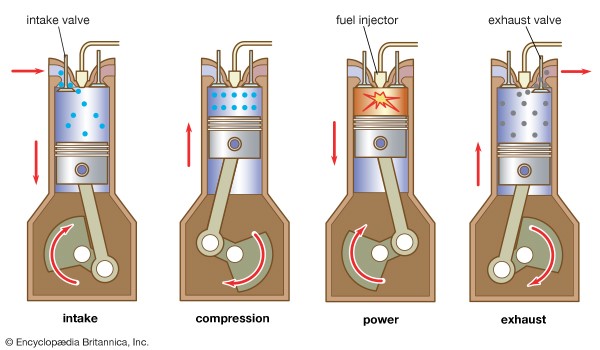
The end result of all these rather complex processes is a spinning plate at the back of the engine called the flywheel (which also balances out the rotary forces of the engine and makes it run smoothly). Please note: The engine produces torque (power is a by-product of torque and engine speed), but for the sake of explanation, we’ll say that both power and torque are the same since they are proportional.
The Drivetrain
So now you have your power, but how does it get to the wheels? The drivetrain in its entirety involves parts that are responsible for getting the power from the engine to the wheels. Drivetrain parts include the gearbox, differential, clutch assembly or torque converter, driveshafts and propshafts.
- Clutch assembly or torque converter
The function of these two is to separate the engine and the wheels while the car is either stationary, pulling away or changing gear. It allows the wheels and the engine to rotate or spin at different speeds. That’s why you can have your engine running while your car is stationary and hence why if you drive a manual car, you need to have your clutch fully pressed when the car is stopped. What kind of clutch mechanism you have depends on what transmission you have on your car: manual, automatic or dual-clutch automatic.
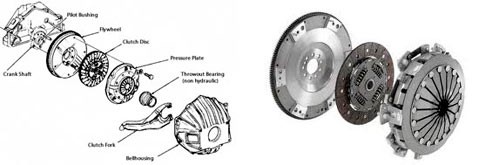
- Here you can see the clutch assembly comprising of the pressure plate, clutch friction disc, flywheel and engine crankshaft
The manual car would have a regular dry and single clutch plate which is operated by your clutch pedal. When the clutch pedal is fully pressed, the clutch friction plate will move away from the engine flywheel only by a few millimetres thus disconnecting the engine and wheels essentially. When you take your foot off the clutch, the clutch friction disc attaches to the flywheel and through friction, they are able to spin at the same speed since the clutch plate grips onto the flywheel. Automatic vehicles have a device called the torque converter which like the clutch, allows the wheels and engine to rotate at different speeds. Unlike the clutch though, the torque converter doesn’t use a friction disc but rather uses an impeller which basically looks like a jet engine turbine. Fluid is pumped onto the impeller using motion from the engine flywheel and this forces the impeller to rotate, thus transmitting power to the wheels. The torque converter is good because it has the ability to multiply the torque or power when the engine is moving slowly (that’s why automatic vehicles pull away fast). The dual-clutch automatic setup is a much more complicated and thus more expensive one. As it says in the name, there are two clutches (one big and the other one smaller) and these two are connected concentrically to two different shafts which are concentric too (one small diameter shaft lies inside another with a larger diameter). Together these are able to engage a gear before it is needed and thus reducing shift times. In fact the gearshift is almost immediate. However, shift times for normal torque converter automatics are getting so good that dual-clutch transmissions will soon be obsolete.
- An exploded diagram of the components that make up the torque converter. Unlike the other clutches, a torque converter is operated by a viscous fluid which translates to smoother power transmission
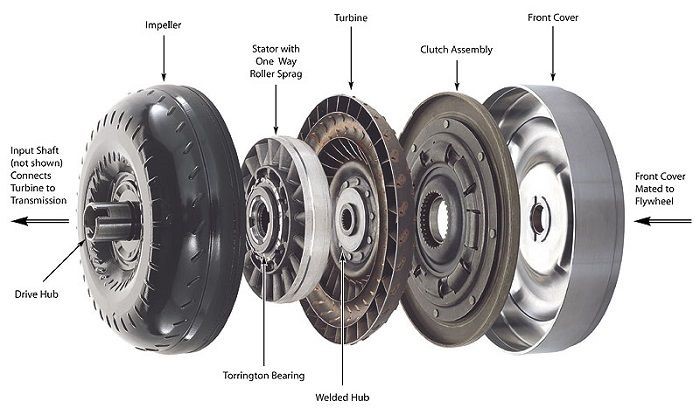
- A diagram of a dual-clutch automatic transmission showing how the two concentric shafts are operated
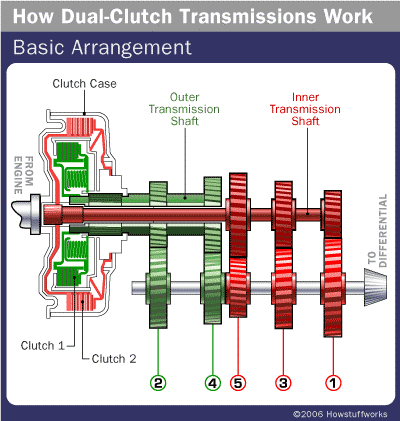
- The Gearbox
This is the casing in which all the gears are found – a gear is a wheel that has teeth and connects to another gear (like a zip) to transmit power from one place to another. Have you ever ridden a bike – a normal bike without the gears? Have you noticed that the faster you pedal, the faster the bike goes? In theory, the fastest speed you can pedal is the fastest speed the bike will go – this is called direct drive. Direct drive is bad in a car because in a car, you want to accelerate fast and also reach a high speed, but you’d have to have an engine with crazy power to do that. So how does a Hyundai i10 manage to accelerate up a hill and still reach way more than 120km/h with an engine that small?
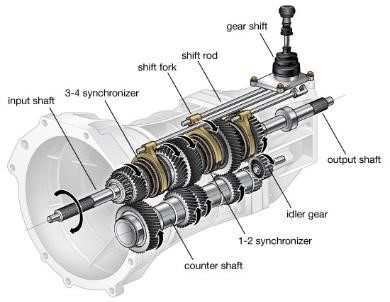
- This is what the rear wheel drive and all-wheel drive gearbox looks like beneath its casing. The input shaft is connected to the engine crankshaft while the output shaft is connected to the propshaft and thus the wheels
Well that’s where gear ratios come in – and each car will have a certain number of gear ratios. For example, a 5-speed gearbox will have 5 gear ratios. Multiple gear combinations (can be two or more) connected together make a ratio. The ratio represents the number of times the engine will rotate for every one rotation of the wheels. The higher you go up the gears when shifting i.e from 1st to 5th gear, the smaller the ratios get. So for example, if first gear has a ratio of 3.35:1, that means the engine will rotate 3.35 times every time the wheels rotate once. If fifth gear will have a ratio of 0.94:1, it means that every time the wheels rotate once, the engine will rotate 0.94 times. A higher gear ratio i.e 3.35:1 will accelerate faster than a lower gear ratio i.e 0.94:1 but its top speed will be low. A low gear ratio will reach very high speeds but the acceleration is not great which is why you pull away in first gear and not in fifth gear, but can only reach around 40km/h in first gear. If this concept is hard to grasp, a little comparative math will solve it. Let’s assume that an engine can rotate at 9000 revolutions per minutes (rpm). Remember, the faster the wheels spin, the faster you go. So in first gear using the 3.35:1 ratio, the wheels will be rotating 3.35 times less than the engine. If the engine is rotating at 9000rpm, the wheels will be rotating at 2687rpm. However, using the fifth gear ratio of 0.94:1, we find that the wheels will be rotating at 9574rpm.
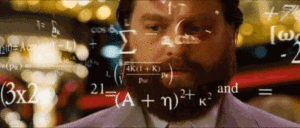
Ergo, on the freeway we use fifth gear or higher. Do note that every car will have its own specific set of gear ratios. So the i10 won’t have the same gear ratios as the C63 we spoke about earlier.
- The Propshaft or Driveshaft
If your car is rear wheel drive like a Gusheshe or all-wheel drive like a Range Rover, it will have this fitted to it. The propshaft is basically a solid and cylindrical part that connects the gearbox to the differential – however sometimes it connects the engine and gearbox if the gearbox (or transaxle) is found with the differential at the rear of the car. You know that part you always see rotating underneath a truck, around the middle? Yep, that’s the propshaft! Its sole function is to transmit the rotary motion and torque from the front of the car to the rear of the car, but not if your car is front wheel drive.
- The Axle Shaft
The axle shafts are just shorter versions of the propshaft. They are the pair of shafts that connect from the differential and then on to their respective wheels. At the wheels, the axle shaft connects to a CV joint (Constant-Velocity joint), which allows power to be transmitted at an angle. That’s why you can accelerate front wheel drive car while turning. If your car is front wheel drive, the axle shaft will be found in the front. And if power goes to the rear, the axle shafts will be found back there. In an all-wheel drive vehicle, you’ll find the axle shafts on every corner of the car.
- The Differential (or Diff)
A differential is a mechanical device which allows the left and right powered wheels to rotate at different speeds. According to physics, if you are turning left, the right wheel will rotate much faster than the left wheel since it has to cover a greater distance in the same amount of time – you can try it you don’t believe me! The differential is able to do this because within its casing, there is a set of gears that make the side-to-side power transmission possible. The differential is connected to the propshaft (in rear wheel and all-wheel drive vehicles) and to the two driveshafts (left and right). In front wheel drive vehicles, they will be part of the gearbox and connect to the two front driveshafts. In all-wheel drive vehicles, which may have up to three differentials (front, centre and rear differentials), they transmit the power from front to back, side to side. There are many different types of differentials which vary in terms of lock they can apply (how much more one wheel can spin more than the other) and how they achieve this lock. Basically though, more differential lock will allow for both wheels to spin at the same speed and thus gain more grip. But too much lock will cause you to actually lose that grip (too much of a good thing) and you end up looking like a Gusheshe at a Spinning event. Too little lock will cause the inside wheel to lose grip and spin while the outside wheel grips religiously. Theoretically, the less power you have, the more differential lock you’d want to have. If you’re running with a lot of power, loosen up that diff bro!
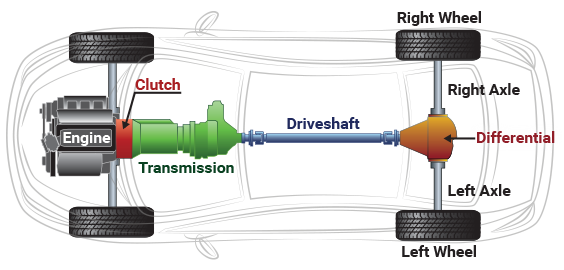
- A diagram showing how the powertrain and drivetrain work hand in hand to get you from A to B
So that’s it right there – the powertrain and drivetrain explained in more than 2600 words (yes, you just read 2600 words). Of course, as I mentioned earlier, there are more profound and expansive ways to explain the two but simple explanations work too. Engineering and physics don’t have to be complicated.
This article was brought to you by:
ProAdvise Car Advisors
Giving you only the best automotive and car buying advice!
Looking for a car? We’ll help you find the best one!
Visit our Facebook page to reach us.
